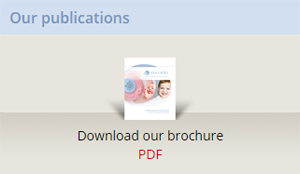In the IVF treatment programs, the term "poor responder" is commonly mentioned. This means that the ovaries of these women show significantly reduced response to the ovarian stimulation drugs that are administered for the recruitment and development of multiple follicles. When compared with the population of women that show normal ovarian response, poor responders produce fewer eggs and have lower pregnancy rates in IVF treatment cycles.
Unfortunately, there is no internationally accepted definition of poor response. The majority of doctors agree that this cohort, includes women that during an IVF cycle recruited and developed less than 3 or 5 follicles and produced less than 3-5 mature eggs even when high gonadotrophin doses and various ovarian stimulation protocols were used.
Various researchers have described numerous criteria, such as: low E2 levels during stimulation, increased FSH levels, low levels of AMH on the 3rd day of the menstrual cycle, at least one cancelled cycle, no response to increased gonadotropin doses, long stimulation duration etc.
High gonadotropin doses (>300IU) exclude the chance of a reduced dosage that may be linked to the small number of follicles that will be recruited and develop.
Another result of the small number of follicles that develop in the ovaries is the low E2 levels during stimulation.
Poor response is due to reduced ovarian reserve. The ovaries are unable to produce more eggs than the ones they already have, even if they are bombarded with high gonadotropin doses.
It is self explanatory that from a small number of follicles, we will retrieve a small number of eggs. If for example the number of eggs collected is 5, only a percentage of these will be mature (i.e. able to fertilise). Only a percentage of these mature eggs will fertilise, divide and have a good implantation potential.
Such loses significantly lower the number of embryos available for transfer. For this reason, poor responders show lower pregnancy rates when compared to women with a normal response.
The factors responsible for poor response may be genetic and environmental, as well as ovarian surgery, endometriosis, immunological, auto-antibodies, reduced number of FSH receptors on granulosa cells, unknown, etc. Ofcourse, the main factor responsible is a reduced ovarian reserve.
Poor responders are not necessarily subfertile when there is no other cause of subfertility.
Prediction of poor response is possible with: a) a basal antral follicle count (e.g. <5 basal antral follicles) by transvaginal ultrasound, b) increased FSH levels (e.g. >12) on the 3rd day of the cycle, c) low AMH levels (e.g. <0.3-0.6 ng/ml). In the past, inhibin-B and GnSAF were used. In IVF treatment, it is especially useful to record the ovarian response to high gonadotropin doses (>300IU) in any previous cycles.
Management of poor responders
Unfortunately, international scientific literature (Tarlatzis, Ubaldi) shows that there is no ideal stimulation protocol.
There have been described and compared: high gonadotropin doses (>300IU), the use of recombinant gonadotropins versus urinary gonadotrophins, administration of gonadotropins in the luteal phase, short and ultra short GnRH agonist protocols with a reduction in the GnRH agonist dose (Arvekap, Daronda, Suprefact), long protocol with agonist administration in the luteal phase, GnRH antagonist protocol, growth hormone (GH) administration, gluco-corticoids administration, use of contraceptives, aromatase inhibitors, DHEA (dehydroepiandrosterone), use of only intracytoplasmic sperm injection (ICSI) for fertilization, assisted hatching, natural cycles, modified natural cycles (M.N.C.) and finally oocyte or embryo donation
Our contribution for poor responders
We have published the largest study in the international literature for poor responders that underwent IVF treatment. Our study was published in the internationally acclaimed scientific journal of Human Reproduction, which is the official journal of the European Society for Human Reproduction and Embryology (ESHRE). It is a prospective randomized study that shows that the flexible GnRH antagonist protocol correlates with statistically higher ongoing pregnancy rates when compared to the short GnRH agonist protocol. In conclusion, the antagonist protocol may be considered as the protocol of choice for women with poor ovarian response that undergo IVF treatment.
See our publication






























